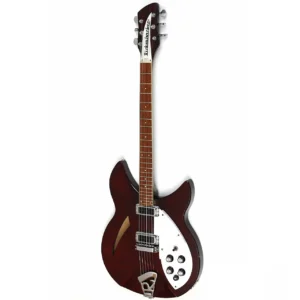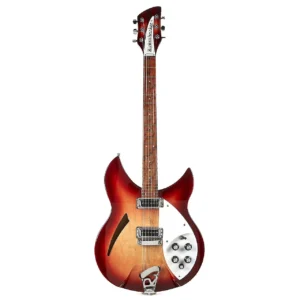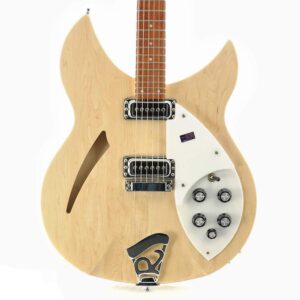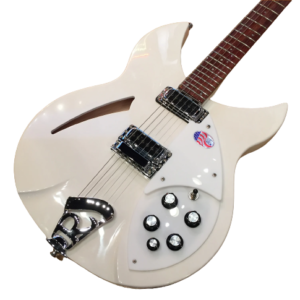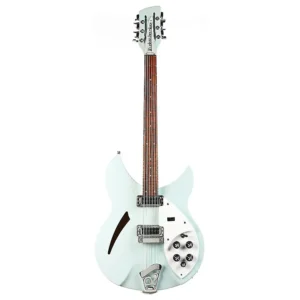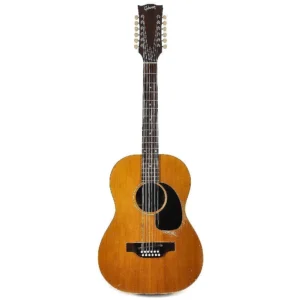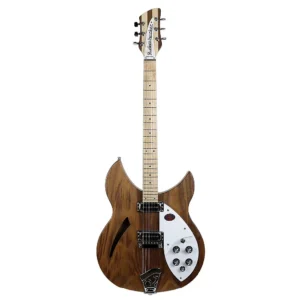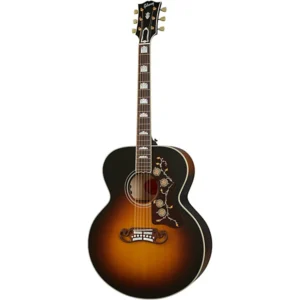Rickenbacker 330
The Rickenbacker 330 is a guitar of Rickenbacker’s 300 series. The 330 debuted in the Rickenbacker product range in 1958, albeit the 300 series was called as the “Capri” series at the time.
Roger Rossmeisl, a German luthier, developed it. Many guitarists identify the guitar with the jangle-rock sounds of bands from the 1960s and 1980s.
Many Rickenbacker guitar elements are included, such as a three-ply maple/walnut neck, a short headstock angle, and a thick rosewood fretboard finished with clear conversion varnish.
Is Rickenbacker 330 a good guitar?
According to previous reviews, Rickenbacker 330 is either a fantastic guitar or they are incredibly picky, but whatever, I am thrilled with the one I received and would recommend it to anyone who wants a RICK but does not want to spend a fortune on one. Again, the fit and finish on mine is flawless, and I have no complaints.
Showing 1–12 of 18 results
Showing 1–12 of 18 results
Rickenbacker 330 Review
The 330 also has Rickenbacker’s “crescent moon” double-cutaway body shape with sharp, unbound edges, as well as a “R”-shaped trapeze tailpiece.
The guitar’s two truss rods, which allow for the adjustment of problematic and undesirable twists as well as curvature of the neck, are one of its quirks. The Rickenbacker 330 has a monaural jack plate and lacks the Rick-O-Sound stereo capabilities seen on other Rickenbacker models such as the Rickenbacker 360.
The Rickenbacker 330, like all Rickenbacker models, is made in the United States, specifically in Santa Ana, California, at the Rickenbacker plant. It is made to order for dealers and individual consumers rather than being mass-produced. It is priced at $1,999.00.
According to Rickenbacker’s CEO, the 330 is the best-selling instrument in the company’s lineup: The 330 is the best-selling model, closely followed by the 360 and 4003. These three alone account for almost 70% of our sales.
Rickenbacker 330 Features
Model specs
- No. Frets 24 (originally 21 until 1970)
- Scale Length 62.9 cm (243⁄4“)
- Neck Width at Nut 41.4 mm (1.63″)
- Neck Width at 12th Fret 49.05 mm (1.931″)
- Crown Radius 25.4 cm (10″)
- Weight 3.6 kg (8.0 lbs.)
- Overall Length 100.3 cm (391⁄2“)
- Overall Width 38.1 cm (15″)
- Overall Depth 38.1 mm (11⁄2“)
- Schaller Machine Heads
Rickenbacker 330s are optimized for and equipped with 10–46 gauge, compressed, round-wound strings:
| String | Gauge (inch) |
|---|---|
| e | .010 |
| B | .013 |
| G | .017 |
| D | .026 |
| A | .036 |
| E | .046 |
Pickups
Rickenbacker’s Hi-Gain single-coil pickups are standard on modern 330s. Previously, the model was outfitted with Rickenbacker’s Toaster pickups.
The Hi-Gains have substantially higher power than the Toasters, although this has resulted in the sound tone of contemporary models differing slightly from that of older, pre-1970s models.
The sound of the old Toaster pickups has been associated with musical bands like as the Byrds and the Beatles, whereas the sound of the modern Hi-Gain pickups is more indicative of groups such as the Smiths and R.E.M.
Fifth control knob
Tone and volume are controlled by two knobs on each of the 330’s two pickups. However, in 1961, a fifth “blend” knob was added to the instrument to broaden the possible tone adjustments.
This knob serves numerous tasks, including tone blending between pickups and general EQ between the bass and treble tones of the instrument. Its principal role, however, is to act as a bass pickup volume adjuster, reducing the normally louder neck pickup to levels comparable to the bridge pickup.
The knob is a potentiometer wired as a variable resistor between the neck pickup and the volume knob on the neck pickup.Because it is only connected to the neck pickup circuit and not the bridge pickup circuit, it only controls the loudness of the neck pickup in the neck and center switch positions and has no effect in the bridge position.
Turning the knob clockwise increases the resistance; greater resistance equals more volume reduction before the signal reaches the volume knob.
On older models, the potentiometer value was 500k, offering variable resistance from 0 to 500k. More current models include a 330k potentiometer with a resistance range of 0 to 330k.
0.0047µF Hi-pass Filter Capacitor
A 0.0047F capacitor was installed between the switch and the volume knob for the bridge/treble pickup on vintage Rickenbacker 330s. Lower frequencies were filtered out by the capacitor, resulting in a more trebly output.
Some players attribute the more vintage “jangly” tone to this capacitor, as contrasted to the more fuller sounding bridge pickup without it.
The bridge pickup’s output volume was reduced as a result of this capacitor. This aided in the development of the fifth control knob for balancing pickup volumes. By the mid-1980s, the capacitor had been removed from the circuit.
On more modern 330s, a popular modification is to reintroduce the capacitor back into the circuit, but it is usually attached to a push/pull potentiometer switch so it can be engaged by pulling up the knob and disengaged by pushing the knob back down – this allows for both the more modern full bridge pickup sound and the thinner, more trebly sound.
Larger “Paddle” Headstock Period
Rickenbacker 330s have a slim headstock form, but from about 1984 to 2007, the headstock size was modified to a wider shape. Originally, this adjustment was made to accommodate larger tuning keys as the manufacturer migrated to a new type of tuner.
The headstock stayed in place throughout the 1990s before being phased out in 2007 due to widespread requests for a return to the narrower headstock form.
Because of its wide width, the large headstock is also known as the “paddle headstock” for its similarity to a boat paddle, and the “Gumby” headstock for its likeness to the clay animation figure’s head shape.
Because these models were constructed to vintage standards, they were immune to the larger headstock alterations and preserved the thinner headstock style during the entire “paddle” headstock period.
Rickenbacker 330 Notable players
- Pete Townshend
- Peter Buck of R.E.M.
- Paul Weller of the Jam & the Style Council
- Brix Smith of the Fall
- Johnny Marr of the Smiths
- Wendy Melvoin of Prince and the Revolution
- The Edge of U2 (12 string version)
- Remi Matsuo of Glim Spanky
- Aviv Geffen
- Joe Hawley of Tally Hall
- Dag Julian of Poi dog pondering





